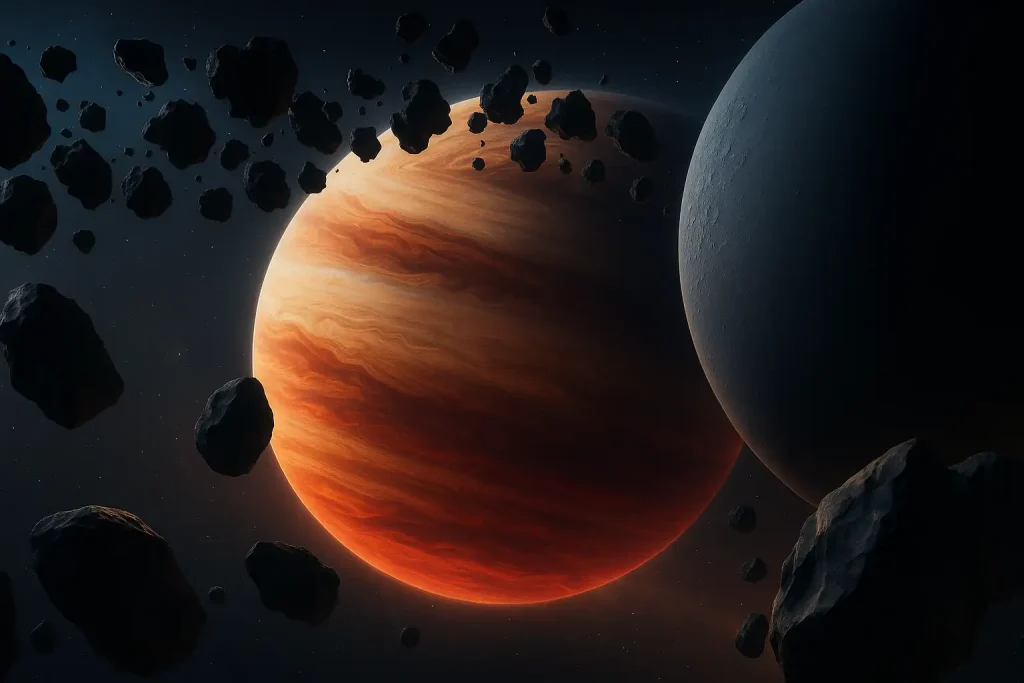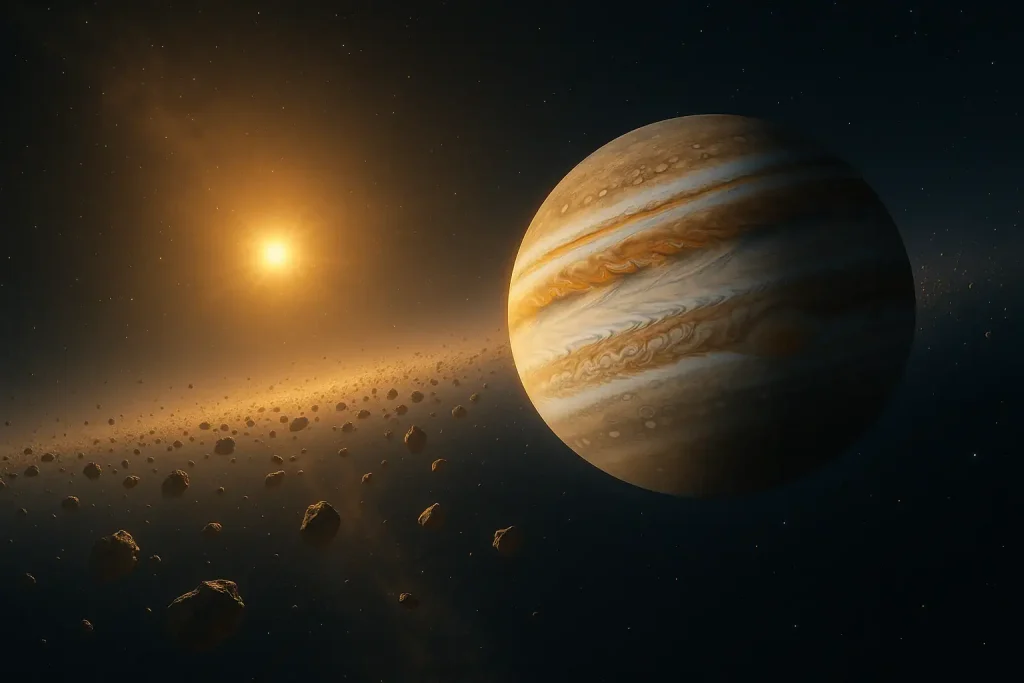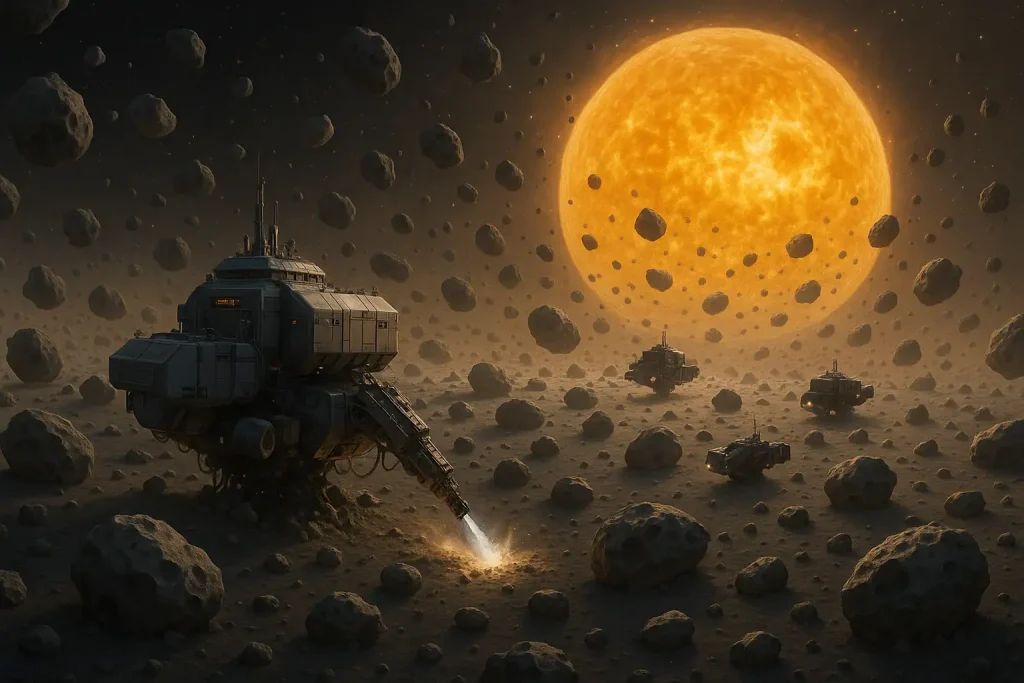Introduction
The Asteroid Belt, a vast ring of rocky debris, sits between Mars and Jupiter. It’s a cosmic graveyard of sorts, filled with remnants from the solar system’s early days. Specifically, this region contains hundreds of thousands of asteroids. These range from tiny pebbles to massive bodies like Ceres, a dwarf planet. For example, Ceres alone accounts for about a third of the belt’s mass. The belt formed 4.6 billion years ago. Back then, the solar system was a chaotic swirl of gas and dust. However, Jupiter’s immense gravity prevented these pieces from forming a planet. Instead, they became a scattered field of rocks. Today, the Asteroid Belt fascinates scientists. It holds clues to the solar system’s origins. Additionally, it poses risks and opportunities. Some asteroids could collide with Earth. Others might be mined for resources. This article explores the Asteroid Belt in detail. It covers its traits, recent discoveries, and exploration efforts. Furthermore, it examines its potential value and a theoretical idea: the belt’s role in time travel studies. Let’s journey into this rocky realm.

Physical Characteristics of the Asteroid Belt
The Asteroid Belt spans a wide area between Mars and Jupiter. Its inner edge is about 2.2 astronomical units (AU) from the sun. The outer edge reaches around 3.2 AU. One AU is the distance from Earth to the sun. For context, Mars orbits at 1.5 AU, and Jupiter at 5.2 AU. The belt contains countless asteroids. However, their total mass is small. It’s less than 4% of Earth’s moon. Ceres, the largest object, has a diameter of 590 miles (940 km). Meanwhile, most asteroids are much smaller. Many are just a few miles across. Others are mere dust particles. The belt isn’t a dense swarm like in movies. Instead, asteroids are spread far apart. For example, spacecraft can pass through without much risk. The asteroids vary in composition. Some are rocky, made of silicate. Others are metallic, rich in iron and nickel. Additionally, some contain carbon or even water ice. Therefore, the belt is a mix of different materials. These traits reflect the solar system’s early conditions. Scientists study them to learn about planetary formation.

Recent Discoveries About the Asteroid Belt
Recent studies have deepened our understanding of the Asteroid Belt. For instance, researchers have analyzed data from the Dawn mission. This mission studied Ceres and Vesta, two major asteroids. Dawn found evidence of water ice beneath Ceres’ surface. This suggests the belt might have once held more water. Additionally, Vesta shows signs of ancient volcanic activity. Its surface has basalt, a volcanic rock. This means Vesta was once geologically active. Another discovery involves the belt’s origins. Scientists now think many asteroids came from beyond Jupiter. They were scattered inward during the solar system’s early chaos. Consequently, the belt is a mix of local and distant objects. Moreover, new telescopes have spotted unusual asteroids. Some have tails like comets. These are called active asteroids. They release dust due to sublimation or impacts. For example, asteroid P/2010 A2 was observed with a tail. Such findings challenge old ideas. The belt isn’t just a static relic. Instead, it’s a dynamic region with ongoing processes.

Exploration of the Asteroid Belt
Exploring the Asteroid Belt is a priority for space agencies. Several missions have targeted its asteroids. For example, NASA’s Dawn mission launched in 2007. It visited Vesta and Ceres, mapping their surfaces. Dawn revealed craters, mountains, and even bright spots on Ceres. These spots are likely salt deposits. Another mission, Japan’s Hayabusa2, studied asteroid Ryugu. It returned samples to Earth in 2020. The samples showed Ryugu contains organic materials. This hints at the building blocks of life. Additionally, NASA’s Psyche mission is underway. It targets a metallic asteroid named Psyche. Scientists believe Psyche is the exposed core of a destroyed planet. The mission aims to learn about planetary cores. Meanwhile, ground-based telescopes also help. They track asteroids to predict potential Earth impacts. For instance, the NEOWISE telescope scans for near-Earth objects. So far, no major threats are confirmed. However, exploration continues. The belt offers both scientific insights and future resources. Mining asteroids for metals or water could support space travel.

Value of Precious Metals in the Asteroid Belt
The Asteroid Belt holds immense potential for precious metals like gold and platinum. Specifically, M-type asteroids are the key targets. These metallic bodies often contain iron, nickel, and rare metals. For example, the asteroid 16 Psyche is a prime candidate. Scientists estimate Psyche could contain metals worth $10,000 quadrillion. That’s far more than the global economy, which is around $142 trillion in 2025. Another asteroid, Davida, is valued at $27 quintillion. These numbers sound staggering. However, they come with a catch. Flooding Earth’s market with such metals would crash their prices. Gold and platinum are valuable because they’re scarce. If supply skyrockets, their value plummets. For instance, historical events like Spain’s influx of gold from the Americas in the 1500s caused inflation. A similar effect could happen here. Moreover, mining these metals is challenging. The technology to extract and return them to Earth doesn’t exist yet. Costs are also astronomical. A 2012 study estimated a single asteroid mining mission at $2.6 billion. Despite this, the metals could be more valuable in space. They might be used to build space stations or fuel depots. Therefore, the true value of the Asteroid Belt’s metals might lie in supporting future space exploration rather than Earth’s economy. Still, the potential is undeniable. It could redefine resource scarcity in the long term.

The Asteroid Belt and Time Travel
Could the Asteroid Belt play a role in time travel? This idea is highly speculative. The belt itself doesn’t directly affect time. However, its location near Jupiter offers a unique opportunity. Jupiter’s massive gravity creates strong relativistic effects. According to Einstein’s theory, time slows in stronger gravitational fields. A spacecraft near Jupiter could experience time dilation. For example, a year in Jupiter’s orbit might equal slightly more time on Earth. The Asteroid Belt, being close to Jupiter, could serve as a staging area. A mission might launch from the belt to study these effects. Additionally, some asteroids contain water ice. This could be turned into fuel for such missions. However, the belt’s chaotic environment poses risks. Collisions with small debris are a concern. Moreover, time dilation near Jupiter is minimal. It’s not enough for practical time travel. Scientists use the belt to study other concepts. For instance, they test orbital mechanics. Nevertheless, time travel remains a distant dream.

Leave a Reply